Unit 11
The Transfiguration, Miracles, And Disciple Training
Unit 11
The Transfiguration, Miracles, And Disciple Training
Chapter 01
The Transfiguration
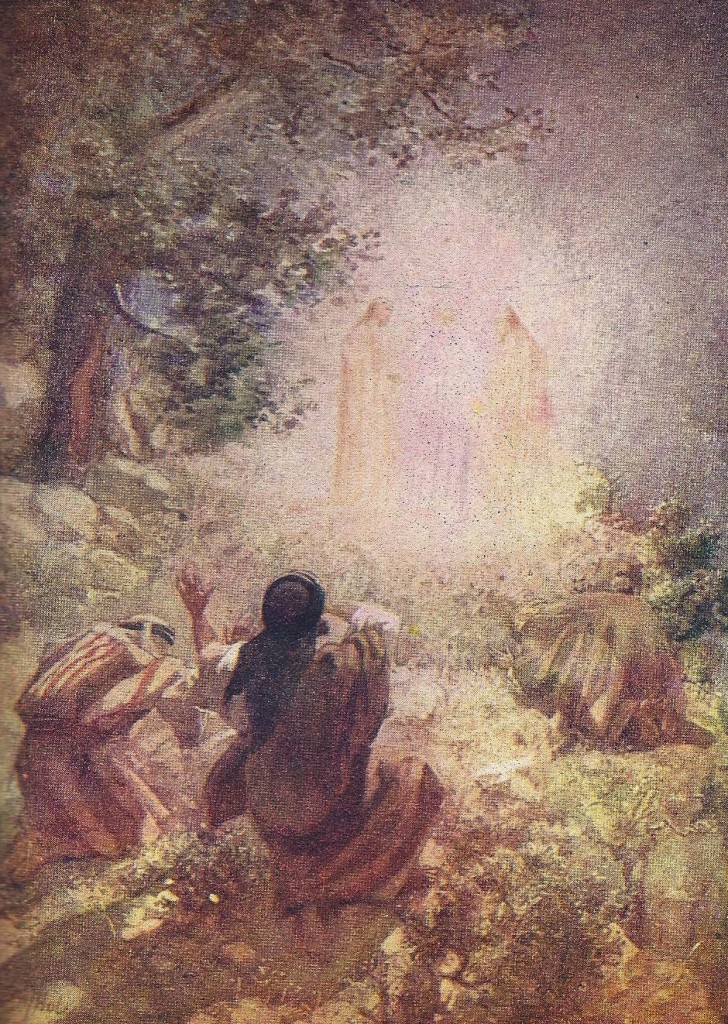 11.01.00.A. THE TRANSFIGURATION OF JESUS. Artwork by William Hole of the Royal Scottish Academy of Art, 1876. Peter, James and John encountered Moses and Elijah in a most profound manner on a high mountain. Moses represented the Law and Elijah represented the prophets.
11.01.00.A. THE TRANSFIGURATION OF JESUS. Artwork by William Hole of the Royal Scottish Academy of Art, 1876. Peter, James and John encountered Moses and Elijah in a most profound manner on a high mountain. Moses represented the Law and Elijah represented the prophets.
11.01.01 Introduction
About a week after Jesus challenged the disciples at the temple of Pan, (a/k/a Banias) located at Banias, a/k/a Caesarea Philippi. The disciples were obviously aware that the life of Jesus, from a human perspective, was profoundly unusual. Their limited understanding of Him as Deity was understandably questionable and sometimes in doubt, because, what mere mortal can understand God? Whatever they did comprehend would be further complicated by His crucifixion. Jesus was now preparing them for the events that lay ahead – His rejection, death, and resurrection. Consequently, from this point on, the dynamics of Jesus as Lord God Almighty intensified.
11.01.02 Mt. 17:1-8; Lk. 9:28-36a (See also Mk. 9:2-8) Mount Hermon
JESUS IS TRANSFIGURED
Mt. 1After six days Jesus took Peter, James, and his brother John and led them up on a high mountain by themselves. 2 He was transformed in front of them, and His face shone like the sun. Even His clothes became as white as the light. 3 Suddenly, Moses and Elijah appeared to them, talking with Him.
Lk. 31 They appeared in glory and were speaking of His death, which He was about to accomplish in Jerusalem. 32 Peter and those with him were in a deep sleep, and when they became fully awake, they saw His glory and the two men who were standing with Him.
Mt. 4 Then Peter said to Jesus, “Lord, it’s good for us to be here! If You want, I will make three tabernacles here: one for You, one for Moses, and one for Elijah.”
5 While he was still speaking, suddenly a bright cloud covered them, and a voice from the cloud said:
This is My beloved Son.
I take delight in Him.
Listen to Him!
6 When the disciples heard it, they fell facedown and were terrified.
7 Then Jesus came up, touched them, and said, “Get up; don’t be afraid.” 8 When they looked up they saw no one except Him – Jesus alone.
History seems to connect great men of God with great mountains. Moses climbed Mount Sinai to receive the tablets of the Law (Ex. 31:18). Later he climbed Mount Nebo where he died and God buried him. Then Elijah climbed Mount Horeb to hear the still small voice of God (1 Kgs. 19:9-12). Now, Moses and Elijah came to another mountain, although its name is not mentioned, to meet with Jesus.
Following the Great Confession of Peter, Jesus went up a high mountain with Peter, James, and John. There He was transfigured (Gk. metamorphoo 3339) [1] and shone in brilliant white. As such, Jesus was mysteriously changed into another form that has often been associated with His heavenly body. [2] He then spoke with Moses and Elijah while the disciples were absolutely stunned. He told them of His coming sacrificial death (Lk. 9:31), that is, His coming “departure” (Lk. 9:30-31), which in the Greek word is exodus meaning, to liberate one from death, which was also a euphemism for death.[3] All this, so mankind would have a way of escape from the world of sin and into the Kingdom of God. By that sacrifice, God was about to fulfill the promise of salvation (represented by Moses) and restoration of mankind (represented by Elijah). The Transfiguration was the dynamic presence of God in the affairs of man, but it also was an anticipation of His death, resurrection, and ascension.
11.01.02.Q1 Did the Transfiguration occur on Mount Tabor or Mount Hermon (Mt. 17:1-8; Mk. 9:2-8; Lk. 9:28-36)?
This issue is seldom a question of students unless they are trying to retrace the steps of Jesus in the land of the Bible or are studying historical geography. But they are not the only ones, as scholars and historians in recent years have debated the same issue. Matthew said they went up on “on a high mountain by themselves.” Mount Tabor was first identified as such by the Byzantines as early as the 4th century, for easy travel by the European pilgrims. North of the Sea of Galilee was the Hula Lake,[4] a massive swampy area that made travel to Mount Hermon most unpleasant. Several centuries later the Crusaders affirmed the Byzantine tradition.[5] But were they right? A discussion of each site is as follows:
Possibly the greatest argument against Mount Tabor is that the village of Atabyrion occupied the entire crest area. It had been continuously occupied for more than two centuries. The very narrow summit was a strategic lookout from which distant travelers and marching armies could be seen. Note the strategic importance over the previous three centuries.
Local tour guides are quick to point out the stone wall fortification uncovered by archaeologists that was built by Josephus and the military unit he commanded – fortification the historian mentions in his writings.[9] Therefore, since the village of Atabyrion and a Roman garrison covered the entire top of this small narrow mountain ridge, Jesus could not possibly have been there to be alone in the presence of God.
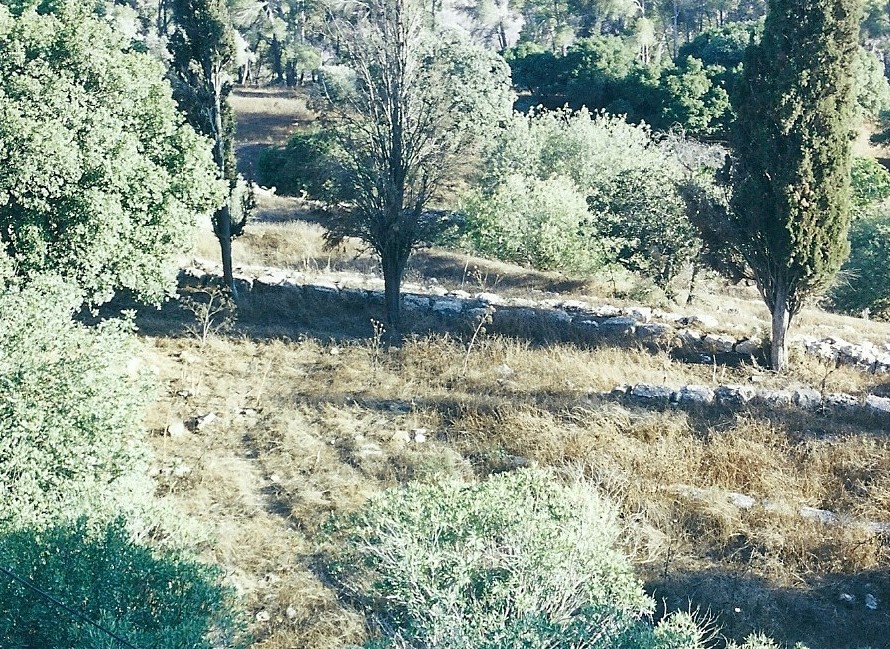
11.01.02.A. FORTIFICATION RUINS BUILT BY JOSEPHUS ON MOUNT TABOR. Low walls are all that remain from the once mighty fortification built by Josephus when he was a commander of a Jewish military unit. Photographed in 2000 by the author.

11.01.02.B. RUINS OF THE VILLAGE OF ATABYRION ON MOUNT TABOR. The ruins of the village upon the narrow ridge of Mount Tabor and the eyewitness report by Josephus are evidence to the summit occupancy at the time of Jesus. The ridge itself is barely a hundred meters wide and three hundred meters long, meaning there would not have been a place where Jesus could have been alone with His two disciples. The Byzantines and Crusaders incorrectly identified it as the Mount of Transfiguration for the convenience of the visiting pilgrims. Photograph by the author.
The argument for this mountain as being the site of the Transfiguration is that Matthew said that Jesus went up “a high mountain,” as opposed to have gone up “the mountain.” The high altitude of nearly 10,000 feet fully meets the demands of the Greek adjective hupselon.[11] Literally, the Greek text reads a high mountain apart.[12] In essence, the internal biblical evidence – the phrase “a high mountain by themselves” – is the clue that strongly argues for this mountain. Furthermore, the literal Greek reads simply “privately,”[13] which could not have occurred upon Mount Tabor.
The multiple peaks of the Mount Hermon range, at the southern edge of the Lebanon Mountain range, are the perfect description because on one in the ancient world would ever have referred to it as “the mountain.”
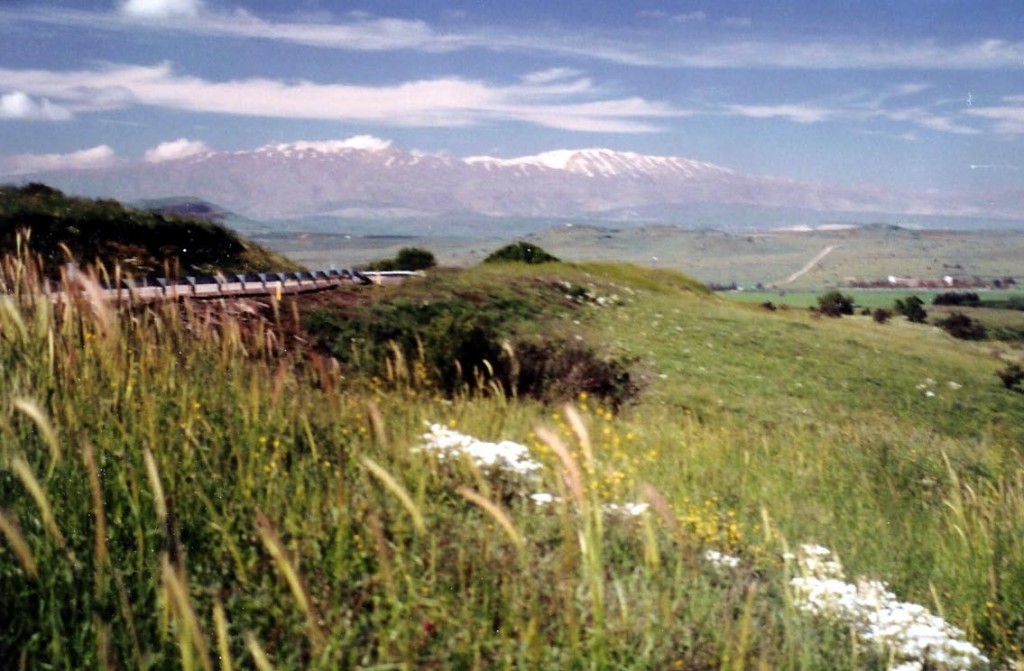
11.01.02.C. SNOW-CAPPED MOUNT HERMON IN LATE SPRING. The Transfiguration most likely occurred somewhere on this distant mountain range. It has no distinctive peak and the highest point rises to more than 10,000 feet above sea level and is snow-covered about six months of the year. Photograph by the author.
Finally, in ancient times, high mountains were used by various cultures to worship their deities. For example, in Babylon, the Tower of Babel was an artificial mountain constructed for the worship of a pagan deity. In the Bible, Abraham offered Isaac on Mount Moriah,[14] later known as the Temple Mount in Jerusalem. Moses met God on Mount Sinai. Jesus ascended to, and will return from heaven, upon the Mount of Olives. The concept of meeting God at a high place carries with it that His subjects ought to be always looking up toward Him. Hence, there is little question that the quiet, remote area to where Jesus retreated was upon mountain of grandeur, Mount Hermon. It should be noted, that a few scholars have suggested Mount Meron in upper Galilee as the possible site, only because the ruins of an ancient village and synagogue have been found there.[15] However, the same argument against Mount Tabor applies for Mount Meron.
“He was transformed.” The language Luke and Matthew used in describing this event reflects the audiences to which they were writing. Matthew used the Greek word metamorphothe, meaning transfigured, while Luke stated that the face of Jesus “became different” or “was altered.” Luke, writing to Greeks may have feared that his readers would reflect how Jesus was similar to their gods who assumed different appearances. But the Jewish audience of Matthew had no problem with the word transfigured, although they were probably astounded by it.[16]As such, Jesus was before the three disciples wearing a brilliant white garment, glistening like the sun.[17] They saw a glorified Jesus they could never have imagined – an image they would not see again until their life’s work was finished. This preview of our Lord’s glorification was not just for them, but for all believers.
“I will make three tabernacles here.” The fact that Peter wanted to build three tabernacles suggests to some scholars that this event may have occurred during the Feast of Tabernacles.
“A bright cloud covered them.” This was the Shekinah Glory of God[18] and was reflective of the Glory of God at the Tabernacle (Ex. 24:15-18), when the temple was dedicated (1 Kg. 1), to the shepherds when Jesus was born, to Stephen (Acts 7:55-56), to Saul of Tarsus (Acts 9:3; 22:6, 11; 26:13), and to the Apostle John (Rev. 21:23).[19] The “cloud” in the Hebrew Bible and rabbinic writings has also been associated with eschatological expectations[20] or with the Exodus.[21] The Voice from the cloud united the Psalms (2:7), the prophets (Isa. 42:1), and the law (Deut. 18:15) in an authoritative testimony to His Sonship and Messiahship.[22] The Transfiguration was a “down payment” or “deposit” of the physical glory that Jesus is going to possess when He reigns as the kingly Messiah.
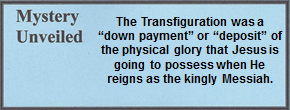
It was an incredible event that Moses and Elijah appeared before them – and that they recognized the two historic figures. But that was not enough, for then a voice from the midst of the cloud said, “This is My beloved, I take delight in Him. Listen to him!” It must have been an incredible experience. Years later Peter said,
17 For when He received honor and glory from God the Father, a voice came to Him from the Majestic Glory:
This is My beloved Son.
I take delight in Him!
18 And we heard this voice when it came from heaven while we were with Him on the holy mountain.
2 Peter 1:17-18
Jesus brought His inner circle of disciples up the mountain to witness the heavenly Shekinah Glory envelope Jesus, the Son of Man. Then came a Voice from heaven, “This is my Son” followed by either “my beloved,” or “my chosen.” After this Jesus spoke openly of His coming death in terms of “his beloved son,” as found in Genesis 22 concerning the sacrifice of Isaac by Abraham. Abraham – “take your son, your only son” who is Isaac. The word only also means “my beloved” or “my chosen.” Abraham took his beloved son and was willing to sacrifice him on the altar to honor God. These words, repeated in 2 Peter, were an echo of the divine approval of the baptism of Jesus earlier in the Jordan River. This was a moment that transformed their lives. In a similar manner, God did sacrifice his Son Jesus for the sins of humanity.
There are two points of interest in this passage.
Scholars have noted several more important aspects to this incredible event. Each one points directly to the passion and ministry of Jesus.[23]
11.01.02.Q2 What is the significance of Moses and Elijah coming to the mountain with Jesus (Mt. 17:3)?
This is a theological question, but is addressed here in a limited sense. Moses was the first of the great prophets. He received the Law personally from God on Mount Sinai, and his ministry included dramatic miracles as part of the exodus story. He has always represented “the Law” (although “Law” better translated as the Instruction) of the Old Covenant and promise of salvation. Elijah was an unusual miracle worker who represented “the prophets,” and his significance is that he was the restorer of all things (Mal. 4:5-6; Mk. 9:11-13). Neither Moses nor Elijah died a normal death. The former was buried by God and Elijah was personally taken away by God.
In Exodus 24:15-18, Moses went up the mountain and a cloud covered it. Now Jesus had taken his three closest disciples with Him up the mountain and again a cloud covered it. The cloud was the glory of God that appeared to His people in various times in their history. The cloud, a/k/a the Shekinah Glory, went before them to guide and protect them (Ex. 13:21). In Numbers 12:5, a cloud descended with the Lord, and the cloud appeared again above the tabernacle (Deut. 31:15). The Lord made His presence known in a cloud in Exodus 19:9, and again some four centuries later when King Solomon dedicated the temple and the cloud filled the temple. Most certainly, these historic events were in the minds of the disciples when they saw the cloud that enveloped Jesus, and the voice of God commanded them to obey Jesus.
The reason Peter may have suggested three shelters (one each for Jesus, Moses, and Elijah) was that they would observe the Feast of Tabernacles that commemorated Israel’s deliverance out of Egypt and also their desert experience. This was the tradition of a coming prophet that the Essenes held in Qumran. Furthermore, they felt that they were living in the last days when the messiah would come, judge the world and destroy their enemies. Then they would then live with him forever. The second tradition of a coming messenger is in Malachi 3:1: “See, I will send my messenger, who will prepare the way before me.” In 4:5 we read, “See, I will send you the prophet Elijah before that great and dreadful day of the Lord comes.”[24]
Another significant point to the appearance of Moses and Elijah is that this entire event points to life beyond the grave. In this context, Moses who died and was buried by God Himself, is a “type and shadow” of the saints who have died and will one day be resurrected. On the other hand, Elijah never died, but was translated (or raptured) and is a “type and shadow” of future saints who will be raptured prior to the Tribulation Period.[25]
“Peter and those with him were in a deep sleep.” It is only natural that they were extremely tired after climbing the highest mountain in Israel – approximately 10,000 feet high.
“Three tabernacles.” The abundantly enthusiastic and courteous Peter proposed a private tabernacle, or shelter of comfort, for each of the three heavenly beings. Obviously, he still had no understanding of the mission of Jesus or of the horrific event that was to occur in the near future. However, after the resurrection and when Jesus breathed on him (Jn. 20:22) his enthusiasm was propelled before the Holy Spirit fell on Pentecost, as he was boldly preaching as the Spirit came upon everyone.
Finally, there are two witnesses in Revelation whose names are not given. One will be given the power to shut the heavens to prevent the rains from falling, and the other will have the power to turn water into blood. These actions describe those miracles performed by Elijah and Moses. Consequently, their work on earth is far from over. The mystery that remains is how Peter and the other disciples recognized them.
11.01.02.Q3 Did the Transfiguration occur in six days or eight?
Matthew and Mark recorded that this event occurred “after about six days,” while Luke said it occurred “after about eight days.” As stated previously, the apparent difference can be simply explained in that there were two methods of counting days: exclusively and inclusively. “Inclusively” would count the six days between the events while “exclusively” count the six days plus the eventful days of travel at either end of the six day period. Luke counted time inclusively while Mark and Matthew counted time exclusively.[26]
[1]. Vine, “Transfigure.” Vine’s Complete Expository Dictionary. 2:639.
[2]. Vine, “Transfigure.” Vine’s Complete Expository Dictionary. 2:639.
[3]. Young, “The Meaning and Purpose of the Transfiguration.” 7:3, 11-15; Fruchtenbaum, The Jewish Foundation of the Life of Messiah: Instructor’s Manual. Class 14, page 11.
[4]. Also known as the plain of El Huleh, or the Sea of Merom,
[5]. Payne, “Tabor, Mount.” 3:1513; Barclay, “Mark.” 209-11.
[6]. Josephus, Wars 2.20.6; 4.1.8 and Antiquities 13.15.4.
[7]. Jung, “Mount Tabor.” 4:714.
[8]. Jung, “Mount Tabor.” 4:714; Josephus, Antiquities 13.15.4.
[9]. Josephus, Wars 2.20.6; 4.1.8 and Antiquities 13.15.4.
[10]. Edersheim, The Life and Times of Jesus the Messiah. 539.
[11]. Johnson Jr., “The Transfiguration of Christ.” 135 n3.
[12]. Bookman, When God Wore Sandals. CD Trac 10. See also Green, Interlinear Greek-English New Testament; Berry, Interlinear Literal Translation of the Greek New Testament.
[13]. Green, Interlinear Greek-English New Testament. 56.
[14]. The Hebrew word for Mount Moriah is har ha-bayit meaning mount of the house. See Mills and Michael, Messiah and His Hebrew Alphabet. 7.
[15]. Gilbrant, “Matthew.” 363.
[16]. Lang, Know the Words of Jesus. 300-302.
[17]. See Dan. 7:9; 12:3; 2 Baruch 51:3, 5, 10, 12; 1 Enoch 38:4; 62:15-16; 104.2; Rev. 3:5, 4:4, 7:9.
[18]. See Ex. 13:21-22; 14:19-20; 33:9-10; Num. 9:15-23; Lev. 16:2; Isa. 6:4-5; 2 Macc. 2:8.
[19]. The Shekinah Glory appeared four times in the life of Jesus: 1) to the shepherds (Lk. 2:8-9), 2) at His baptism (Mt. 3:16), 3) at the transfiguration (Mt. 17:5) and, 4) at His ascension (Acts 1:9).
[20]. Ps. 97:2; Isa. 4:5; Ezek. 30:3; Dan. 7:13; Zeph 1:15; see also 2 Baruch 53:1-12; 4 Ezra 13:3; 2 Macc. 2:8; Babylonian Talmud, Sanhedrin 98a; Lk. 21:37; 1 Thess 4:17.
[21]. Exodus 13:21-22; 16:16; 19:16; 24:15-18; 40:34-38; See also Carson, “Matthew” 8:386.
[22]. Johnson Jr., “The Transfiguration of Christ.” 138.
[23]. Johnson Jr., “The Transfiguration of Christ.” 139-43.
[24]. Pentecost, The Words and Works of Jesus Christ. 259.
[25]. See Appendix 2 as well as “Type and shadow” in Appendix 26.
[26]. Hiebert, “Transfiguration.” 16:2-61; Stein, R. Jesus the Messiah. 167.
11.01.03 Mt. 17:9-13; Lk. 9:36b; (See also Mk. 9:9-13) Mount Hermon
APOSTLES ASK ABOUT ELIJAH
Mt. 9 As they were coming down from the mountain, Jesus commanded them, “Don’t tell anyone about the vision until the Son of Man is raised from the dead.”
10 So the disciples questioned Him, “Why then do the scribes say that Elijah must come first?”
11 “Elijah is coming and will restore everything,” He replied. 12 “But I tell you: Elijah has already come, and they didn’t recognize him. On the contrary, they did whatever they pleased to him. In the same way the Son of Man is going to suffer at their hands.” 13 Then the disciples understood that He spoke to them about John the Baptist.
Lk. 36a They kept silent, and in those days told no one what they had seen.
“Don’t tell anyone about the vision.” Literally, “Don’t tell anyone what you have seen.” At this point Jesus was still concerned that the Jews were expecting Him to be a political messiah. He is totally against anyone promoting Him. It was one of the many features that made Jesus distinctively different from others who claimed to be the messiah – they told everyone to spread the news about themselves. Jesus didn’t. His identity was the subject of countless debates as Jesus performed miracles of greater power than did Elijah.
The Pharisees asked Jesus, “Why then do the scribes say that Elijah must come first?” Jesus confirmed that “Elijah,” of whom Malachi (4:5) spoke, came in the form of John the Baptist. They were correct in saying that Elijah would come before the Messiah, but they believed him to literally return from heaven as the same physical person he was centuries earlier. Furthermore, they believed that he would function with the messiah to purify Judaism from the Greek influences and restore the Jewish people to the political greatness associated with King David. This steadfast mindset prevented many from recognizing the identity of both John the Baptist and Jesus. This also explains, in part, why Jesus was so careful in demonstrating His identity to the Jews rather than making a public announcement.
Now the darkest hour of Jesus and the disciples lay before them. The previous discussion at the Shrine of Pan at Banias resulted in Peter’s profound confession. Now the experience of the Transfiguration would build their faith for the coming painful and agonizing trial and crucifixion. The mountaintop experience was a prelude of what was to come. They had seen Jesus as they had never seen Him before. Yet, unknown to them, they would see Him again in a similar manner after the resurrection. But a fuller meaning of the Transfiguration would not be realized until after the resurrection when Jesus would again walk among them again.
An example of the misunderstanding of “Elijah” is found in the Mishnah. The author believed Elijah would be a man who would bring peace to the descendants of Moses.
Rabbi Joshua said: “I have received as a tradition from Rabban Johanan b. Zakkai,[1] who heard from his teacher, and his teacher from his teacher, as a Halakah given to Moses from Sinai, that Elijah will not come to declare (what is) clean or unclean, to remove afar or to bring nigh, but to remove afar those (families) that were brought nigh by violence and bring nigh those (families) that were removed afar by violence.”
Mishnah, Eduyoth 8.7
From this quotation it is clear that the teacher believed that Elijah, when he would return, would not change the Torah, but would restore justice to human relationships. Yet both John and Jesus underscored the Torah and, in so doing, they challenged the Oral Law.
All this illustrates the difficulties Jesus had to overcome in preparing the disciples for what was before them. They were under His continuous teaching and had often heard of His death and resurrection, either directly or indirectly. Even so, they still failed to comprehend what they were about to witness.
[1]. Rabbi Zakkai was the last disciple of the famous Rabbi Hillel. See Parry, The Complete Idiot’s Guide to the Talmud. 38-39.
Unit 11
The Transfiguration, Miracles, And Disciple Training
Chapter 02
More Miracles And Discipleship Training
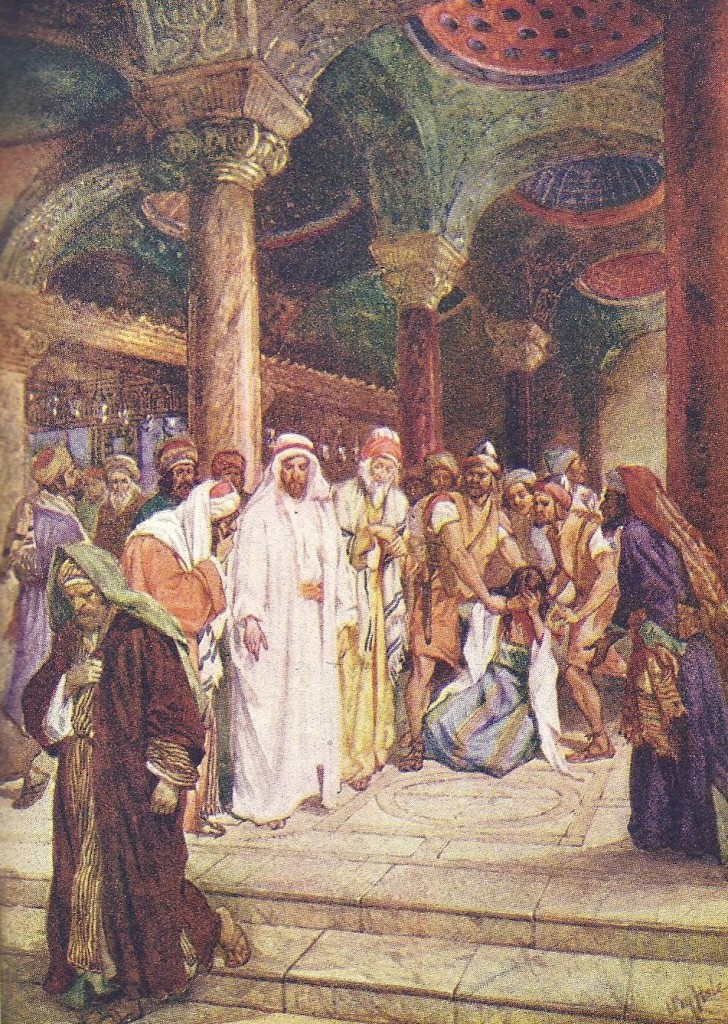
11.02.00.A. JESUS AND THE ADULTEROUS WOMAN. Artwork by William Hole of the Royal Scottish Academy of Art, 1876. Who is without sin among you? Jesus forgave the woman accused of adultery and confronted her accusers, one of whom was probably as guilty as she and, with the others, “set up” this event to challenge Jesus. See John 7:14-16.
11.02.01 Lk. 9:37; Mk. 9:14-28; Mt. 17:20-21 (See also Lk. 9:38-43a; 17:5-6) Near Mount Hermon
THE “EPILEPTIC” BOY HEALED
Lk. 37 The next day, when they came down from the mountain, a large crowd met Him.
Mk. 14 When they came to the disciples, they saw a large crowd around them and scribes disputing with them. 15 All of a sudden, when the whole crowd saw Him, they were amazed and ran to greet Him. 16 Then He asked them, “What are you arguing with them about?”
17 Out of the crowd, one man answered Him, “Teacher, I brought my son to You. He has a spirit that makes him unable to speak. 18 Wherever it seizes him, it throws him down, and he foams at the mouth, grinds his teeth, and becomes rigid. So I asked Your disciples to drive it out, but they couldn’t.”
19 He replied to them, “You unbelieving generation! How long will I be with you? How long must I put up with you? Bring him to Me.” 20 So they brought him to Him. When the spirit saw Him, it immediately convulsed the boy. He fell to the ground and rolled around, foaming at the mouth. 21 “How long has this been happening to him?” Jesus asked his father.
“From childhood,” he said. 22 “And many times it has thrown him into fire or water to destroy him. But if You can do anything, have compassion on us and help us.”
23 Then Jesus said to him, “‘If You can’? Everything is possible to the one who believes.”
24 Immediately the father of the boy cried out, “I do believe! Help my unbelief.”
25 When Jesus saw that a crowd was rapidly coming together, He rebuked the unclean spirit, saying to it, “You mute and deaf spirit, I command you: come out of him and never enter him again!”
26 Then it came out, shrieking and convulsing him violently. The boy became like a corpse, so that many said, “He’s dead.” 27 But Jesus, taking him by the hand, raised him, and he stood up.
28 After He went into a house, His disciples asked Him privately, “Why couldn’t we drive it out?”
Mt. 20 “Because of your little faith,” He told them. “For I assure you: If you have faith the size of a mustard seed, you will tell this mountain, ‘Move from here to there,’ and it will move. Nothing will be impossible for you. [21 However, this kind does not come out except by prayer and fasting.]”
“The next day, when they came down from the mountain.” Jesus and the disciples stayed on the mountain overnight – probably because climbing to the high summit was exhausting. The foot trails are winding and near the summit are huge rocks. Climbing up or down is not for the light hearted.
“My son … has a spirit.” Matthew used the word seleniazesthai, a verb that means to be moonstruck.[1] This term offers two suggestions:
Some scholars have attributed the symptoms to be descriptive of epileptic seizures because demons take on the appearance of various diseases. Others say that in a superstitious culture, illnesses that cause strange body movements were attributed to demons due to the ignorance of the common people. However, for them to declare that the boy simply had the disease of epilepsy is to say that Jesus did not know the difference between a disease and demonic oppression. This was hardly the case.
As previously stated, demons are synonymous with unclean spirits,[2] who are connected with Satan,[3] and are in total opposition to God and the work of God [4] and as such, promote all forms of idolatry.[5] They oppose the faith of believers,[6] and attempt to influence and disturb the physical, mental and emotional well-being of people.[7] However, while certain ailments may be connected with demonic powers, the laws of Moses that pertain to sanitation clearly indicate that good health is also a matter of cleanliness – meaning that many diseases are not related to demonic influences but can be prevented.
Many in the ancient world believed that epilepsy was caused by demonic activity. For example, Aretaeus of Cappadocia (c 130-200 A.D.) was a Greek physician who practiced in Alexandria and Rome. He is noted for having written eight medical books in which he detailed symptoms and diagnostic characteristics of various diseases.[8] His most noted work is the identification of a disease well known today, that he named diabetes.[9] Concerning epilepsy, he said it was known as “the sacred disease” and believed a possible cause was demonic activity.[10]
“He foams at the mouth.” The term foam (Gk. aphrizo 875) denotes to foam at the mouth,[11] and was considered a confirmation of demonic possession.
“You unbelieving generation!” These stinging words were not directed toward the leading Pharisees, but to His own disciples! Clearly, Jesus was frustrated with them! Previously they had been given the power to cast our demons and perform healings, (Mt. 10:1) but here they failed. These words were also reminiscent of the critical comments Moses made in Deuteronomy 32:5 and 20 to the Israelite forefathers. Unbelief was the reason the disciples failed to cast out the demons they encountered even though they had been successful previously. The boy’s father recognized his difficulty and said, “I do believe; help me overcome my unbelief!” With this, Jesus freed the son from the demonic oppression. Then the disciples approached Jesus privately and asked why they had been unsuccessful. Jesus gave them two reasons:
“You will tell this mountain, ‘Move from here to there,’ and it will move.’” Mountains were symbolic of kings and kingdoms, as indicated in the book of Revelation that has many references to mountains being kingdoms. In this case, Jesus spoke of the power that was available to His disciples to move demonic kingdoms (“mountains”). But telling a mountain to move was also a proverbial statement for accomplishing a difficult task.[12]
Everyone knew that these words had the imagery of the famous Herodian, the summer palace-fortress built by Herod the Great. To build it, his slaves and servants relocated the top of a small mountain and had it placed on the top of another nearby mountain, thus making it higher and in the shape of a volcano. Hence, Jesus essentially said that by faith His disciples would be able to perform greater feats than Herod.
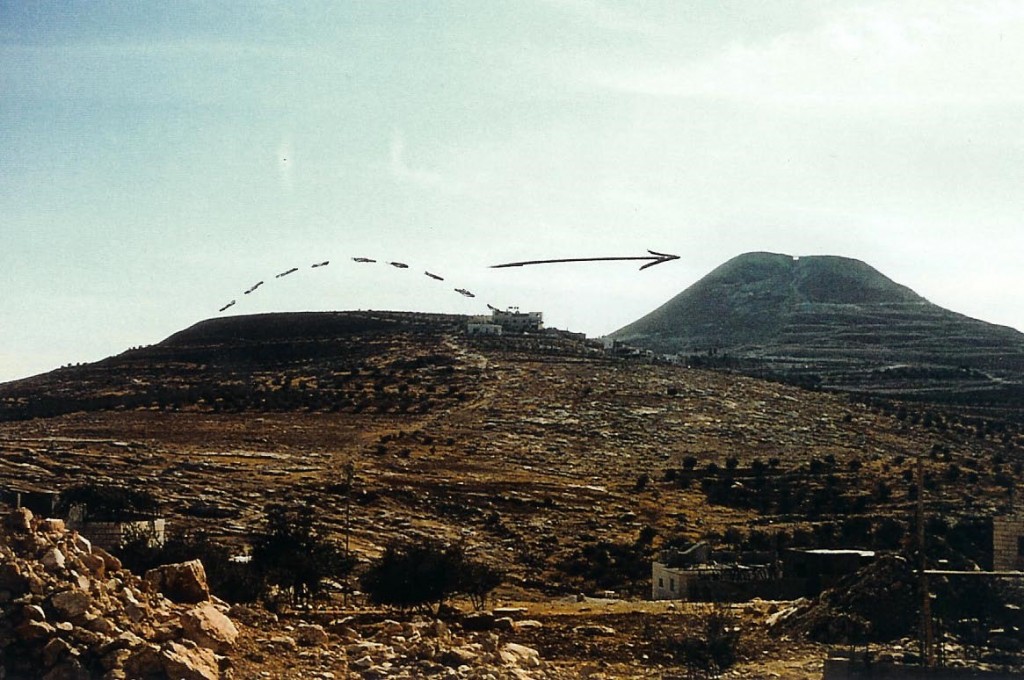 11.02.01.A. THE MOUNTAIN MOVED BY HEROD THE GREAT. The volcano-shaped Herodian Fortress-palace was created when Herod relocated one mountaintop and placed it upon another, and then built his palace-fortress upon it. Located only about two miles south of Bethlehem, this architectural achievement was built with slave laborers and was the backdrop to the words of faith spoken by Jesus. Photograph by the author.
11.02.01.A. THE MOUNTAIN MOVED BY HEROD THE GREAT. The volcano-shaped Herodian Fortress-palace was created when Herod relocated one mountaintop and placed it upon another, and then built his palace-fortress upon it. Located only about two miles south of Bethlehem, this architectural achievement was built with slave laborers and was the backdrop to the words of faith spoken by Jesus. Photograph by the author.
[1]. Barclay, “Matthew.” 2:166.
[2]. Mk. 5:12, 15; 3:22, 30; Lk. 4:33.
[3]. Lk. 10:17-18; 11:19-20.
[4]. 1 Cor. 10:20-21.
[5]. Rev. 9:20; 16:13-14.
[6]. 1 Tim. 4:1.
[7]. Lk. 13:11, 16; Mk. 5:2-5; 7:25; Mt. 12:45.
[8]. http://en.wikipedia.org/wiki/Aretaeus_of_Cappadocia Retrieved December 7, 2013.
[9] . http://www.britannica.com/EBchecked/topic/33531/Aretaeus-Of-Cappadocia Retrieved December 7, 2013.
[10]. Vincent, Word Studies in the New Testament. 1:346.
[11]. Vine, “Foam.” Vine’s Complete Expository Dictionary. 2:244.
[12]. See. Isa. 41:15; 54:10; Hab. 3:10; Zech. 4:7; Babylonian Talmud, Berakot 63b.
11.02.02 Mk. 9:30-32 (See also Mt. 17:22-23; Lk. 9:43b-45) Galilee
DEATH PREDICTED AGAIN
30 Then they left that place and made their way through Galilee, but He did not want anyone to know it. 31 For He was teaching His disciples and telling them, “The Son of Man is being betrayed into the hands of men. They will kill Him, and after He is killed, He will rise three days later.” 32 But they did not understand this statement, and they were afraid to ask Him.
Jesus again spoke of His coming death and resurrection. [1] Even though He was very clear about this issue, the disciples still failed to understand. They must have questioned how it could be possible that the Messiah would die, especially Jesus, the One who healed the sick and raised the dead. The thought of His death was completely illogical.
Yet, it was not until after His resurrection that the purpose of the crucifixion began to make sense. The Apostle Paul’s most distinctive doctrines are expositions of the meaning of two great facts – the death and resurrection of Christ Jesus and the mission of the Spirit by the glorified Redeemer. It is obvious that these incredible details could not be fully explained by Jesus personally, as they had not yet taken place. However, to suppress the inspired explanation of them would be to extinguish the light of the gospel and rob Christ Jesus of His crowning glory.
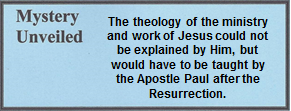
[1]. The first time Jesus predicted His death was in Mt. 16:21-28; Mk. 8:31-35, and Lk. 9:21-27. The second time was in Mt. 17:22-23; Mk. 9:30-32 and Lk. 9:44-45. And the third time was in Mt. 20:17-19; Mk. 10:32-34 and Lk. 18:31-34.
11.02.03 Mt. 17:24-27 Capernaum, March, 29.
COIN FROM THE MOUTH OF A FISH
24 When they came to Capernaum, those who collected the double-drachma tax approached Peter and said, “Doesn’t your Teacher pay the double-drachma tax?”
25 “Yes,” he said.
When he went into the house, Jesus spoke to him first, “What do you think, Simon? Who do earthly kings collect tariffs or taxes from? From their sons or from strangers?”
26 “From strangers,” he said.
“Then the sons are free,” Jesus told him. 27 “But, so we won’t offend them, go to the sea, cast in a fishhook, and take the first fish that you catch. When you open its mouth you’ll find a coin. Take it and give it to them for Me and you.”
This event refers to the half-shekel temple tax that was instituted by Moses[1] and, according to the Oral Law, it had to be paid by the 15th day of Adar (March).[2] Only men who were aged twenty or older were required to pay the tax. This tax supported the tabernacle in ancient times. Later it supported Solomon’s temple followed by the second temple. Those who did not pay in Jerusalem could do so at a city such as Capernaum.[3]
The required coinage for payment of the temple tax (Mt. 17:24-27) is an excellent example to highlight the depraved and decadent nature of the Sadducees. In the days of Jesus, Caiaphas had a small army of tax collectors who secured funds to defray the expenses of the temple. Messengers, known as shelihim,[4] were sent out from Jerusalem to collect the required taxes. The collection in the Holy Land began on the first day of Adar, which is in the modern February and March calendar. The collection continued until Passover in Nisan. Money exchangers also went to the various towns and exchanged foreign currency for shekels that were minted previously by Simon the Maccabee. In foreign countries, every city where there was a Jewish population, a central collection point was established were the taxes could be paid. These funds were later shipped to Jerusalem and used for temple maintenance. Whether one gave a drachma or other coin, the Sadducees always demanded the Tyrian silver shekel.[5] Neither Jewish nor Roman coins were acceptable, but only the Tyrian silver half-shekel because of its silver purity and consistent weight.[6] It did not matter that the coin had the image of the Phoenician deity Melkhart (or Melqarth-Herakles) on the obverse side and on the reverse side, appeared an eagle on the bow of a ship with the legend: “Tyre the Holy and City of Refuge,” and the date of issue. This greatly offended righteous Jews as well as a great many Pharisees. They had to pay two taxes.
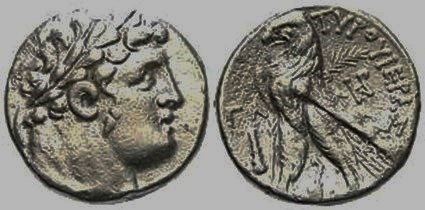
11.02.03.A. THE TYRIAN SILVER HALF-SHEKEL. The Tyrian Silver shekels were minted in the Phoenician cities of Acco and Tyre between 126 B.C. and A.D. 66 and replaced the Greek coins of Alexander the Great. Tyrian shekels had a minimum of 92 percent silver content, had images of pagan kings (deified), an aggressive eagle, and Marduk, a/k/a Melqarth-Herakles, the Tyrian god, and were the coins of choice by the Sadducees. Some scholars believe that only after the Romans shut down the Phoenician mint in 18 B.C. did the Jews mint their own silver shekels near or in Jerusalem.
However, there was a problem: To circumvent the first and second commandments (Ex 20:3-4; Deut. 4:16-18, 5:8), that Sadducees was said that the pagan stigma was removed if the coin was placed in a box rather than conveyed personally to a priest or other temple official. Those who had other currencies, including Jewish coins from the Maccabean Period, had to exchange currencies with money changers who charged a set 8% fee.[7] Ironically, it was this conflict of Jewish vs. Greek values that had previously sparked the Maccabean Revolt. Now the Jewish leaders required coins with the image of a pagan deity and statement that Tyre was the holy city, not Jerusalem.
The disrespect for the biblical commandments goes beyond merely accepting the pagan shekel of a foreign nation. Nonetheless, the Sadducees wanted their silver shekels, probably so they could charge high conversion rates to the thousands of Jews who did not have them. To compensate for the loss, a new mint suddenly appeared. Some scholars believe that a Jewish mint opened near Jerusalem where Tyrian shekels were produced between the years 18 B.C. and A.D. 69/70.[8] Not only did the Sadducees demand Tyrian shekels, but it appears that they had their hands in the production of them as well. How extensive their participation was is unknown, but the level of corruption is beyond imagination.
Jesus again demonstrated a lesson in humility. He was King of kings and Lord of lords and yet recognized those who held religious power and authority. Because priests and prominent rabbis were exempted from the tax, neither He nor His disciples were required to pay the tax either. However, for the purpose of preventing a conflict with the temple tax collectors, the tax was paid anyway to a religious system that had become corrupt and spiritually dead.
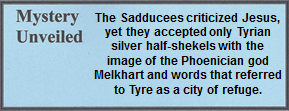
“Double-drachma.” A Greek drachma was the wage paid for two days of labor. In terms of monetary exchange, a half shekel equaled two drachma and a drachma was equal to the Roman Denarius.[9]
Video Insert >
11.02.03.V The Fishing Miracle of Humility. Professor Gordon Franz discusses Matthew 17:24-27 where Jesus demonstrated humility when paying the temple tax (5:23).
[1]. Exodus 30:11-16. See also 2 Kings 12:4; 22:3-7 and Nehemiah 33-34.
[2]. Mishnah, Shekalim 1:1; Smith, Augsburg Commentary on the New Testament: Matthew. 212-14.
[3]. Franz, http://www.lifeandland.org/2009/02/the-tyrian-shekel-and-the-temple-of-jerusalem/ Retrieved October 10, 2014; Franz, “Does Your Teacher not Pay the Temple Tax?” 81-82.
[4]. Geikie, The Life and Words of Christ. 2:264.
[5]. Franz, “Jesus Celebrates Hanukkah.” 116-19.
[6]. Kadman, “Temple Dues and Currency.” 1:9-10.
[7]. Hendin, Guide to Biblical Coins. 114-16.
[8]. Franz, http://www.lifeandland.org/2009/02/the-tyrian-shekel-and-the-temple-of-jerusalem/ Retrieved Oct. 20, 2014. Not all scholars agree on the date of minting coins near the Holy City in this time frame, as others believe it was during the First Revolt (A.D. 66-70), and possibly in the city at that time.
[9]. Gilbrant, “Matthew.” 369; Appendix 20.
11.02.04 Mk. 9:33-35; Lk. 47-48; Mt. 18:5 Capernaum
APOSTLES DISPUTE ABOUT RANK
Mk. 33 Then they came to Capernaum. When He was in the house, He asked them, “What were you arguing about on the way?” 34 But they were silent, because on the way they had been arguing with one another about who was the greatest. 35 Sitting down, He called the Twelve and said to them, “If anyone wants to be first, he must be last of all and servant of all.”
Lk. 47 But Jesus, knowing the thoughts of their hearts, took a little child and had him stand next to Him.
48 He told them,
“Whoever welcomes this little child in My name
welcomes Me.
And whoever welcomes Me
welcomes Him who sent Me.
For whoever is least among you—
this one is great.”
Mt. 5 And whoever welcomes one child like this in My name welcomes Me.
This discussion occurred shortly after the transfiguration. Peter, James, and John witnessed the event while the other nine disciples were some distance away and felt left out. Their feelings of disconnect were heightened after the three returned and told what they saw. Naturally the feeling that certain individuals had become the favorite disciples of Jesus intensified.
Jesus makes the comparison of a child to a believer who has his faith in Him. The common opinion or interpretation is that children are innocent – which is incorrect. The correct interpretation is that children have absolute faith in their parents and so likewise believers are to have absolute child-like faith in God. Furthermore, a child understands that he is under the authority of his parents, so likewise, believers are under the authority of God. In Luke’s version the children come to Jesus while in Matthew’s rendering the children have faith in Jesus. While there is a difference in the English between the two gospels, to the Jews reading these two gospels there was no difference – both gospels report the same concept.
“What were you arguing about on the way?…who was the greatest.” They were too embarrassed to reveal the truth, but since Jesus already knew it, He spoke on the issue they were thinking: “Who would be the greatest in His kingdom?” This was a point of contention because the disciples still thought that in some manner Jesus would destroy the Roman Empire and establish His Kingdom of God as a political entity. This was an on-going issue and obviously, they were far from understanding who Jesus was. He responded by giving them a lesson on servant-hood. In the ancient Middle East culture, as today, social position and dignity were highly important. An example is found in the Messianic Rule of the Dead Sea Scroll:
And the (Mess)iah of Israel shall come,
And the chiefs of the (clans of Israel) shall sit before him,
Each in the order of his dignity
According to (his place) in their camps and marches.
Dead Sea Scroll, Messianic Rule 1QSa 2:11[1]
It is easy for modern readers to conclude this was simply a matter of greed and position. That is not to say these issues were not present, but the issue of rank was important in their hierarchical culture of honor.[2] Even today, persons of advanced age and visitors are honored to a much higher degree there than in Western countries.
[1]. Vermes, The Dead Sea Scrolls in English. 121; Bailey, Poet and Peasant. Part II, 90. Words/letters in parentheses were added since these are missing in the damaged manuscript.
[2]. Bock, Jesus According to Scripture. 240.